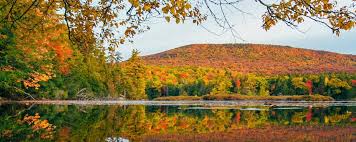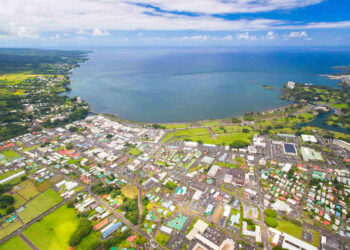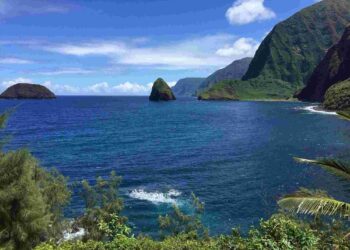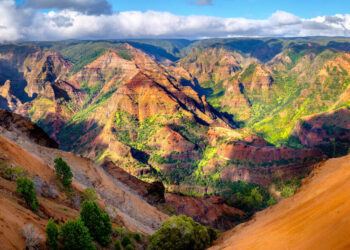Tucked into the northeastern reaches of New York State, the Catskill Mountains rise as a rugged counterpoint to the Hudson Valley’s gentler slopes. Spanning roughly 6,000 square miles across Ulster, Greene, Delaware, and Sullivan counties, this region melds dense forests, plunging waterfalls, and high peaks into a landscape of untamed beauty. Once a retreat for 19th-century urbanites escaping cholera-ridden cities, the Catskills later bloomed as the Borscht Belt, a Jewish resort haven of comedy and camaraderie. Today, it draws hikers, artists, and those craving solitude, its seasons painting a vivid arc—spring’s tender greens, summer’s thick canopies, autumn’s blazing reds, and winter’s stark whites.
Notable Insight: The Catskills aren’t true mountains by geological measure but a dissected plateau, carved by ancient streams into peaks that top out at 4,180 feet on Slide Mountain—a subtle distinction lost on anyone gazing at their majesty.
How To Reach
The Catskills lie within a two- to three-hour journey from New York City, depending on your destination. From Manhattan, Amtrak’s Empire Service rolls to Hudson (two hours, $40-$60), where rental cars or local buses like Trailways (fares around $20) ferry you westward into the hills. Driving via Interstate 87 north to exits like 19 (Kingston) or 20 (Saugerties) offers flexibility; Route 28 then threads through the heart of the range. Albany International Airport, 50 miles north, serves as a closer aerial entry, with car rentals bridging the gap. Avoid peak fall weekends—traffic clots the roads as leaf enthusiasts swarm.
Places to Visit
Woodstock
Less tied to the 1969 festival (held 60 miles south in Bethel) than its bohemian spirit, Woodstock thrives on art and nature. Tinker Street’s galleries and cafes—like the woodsy Bread Alone with its $5 sourdough—pulse with creativity. Bearsville Theater, a restored barn, hosts folk acts; tickets hover at $30. Nearby Overlook Mountain climbs to 3,140 feet, its fire tower framing the Hudson Valley for free, though the two-mile ascent tests resolve.
Hunter
A skier’s haven, Hunter Mountain towers at 4,040 feet. Winter lift tickets start at $80, carving runs through powdery glades, while summer unveils the Skyride ($15) to summit views. The Kaaterskill Rail Trail, a flat three-mile stretch, winds past ruins of old hotels—free and serene. Hunter Village’s antique shops and taprooms, like Hunter Mountain Brewery ($8 pints), beckon post-adventure.
Phoenicia
This hamlet hugs the Esopus Creek, a fly-fishing and tubing magnet—rentals run $20 daily. The Empire State Railway Museum, housed in a 1917 depot, opens weekends for $5, tracing rail history. Panther Mountain looms nearby; its five-mile loop reveals a glacial cirque, rewarding effort with solitude. Sweet Sue’s pancakes ($12) fuel mornings with syrup-soaked heft.
Catskill Village
On the Hudson’s west bank, this spot blends river and ridge. The Thomas Cole National Historic Site, home to the Hudson River School founder, opens its cedar-shaded grounds for $15, unveiling sketches of peaks he immortalized. Catskill Park’s trails—like the Escarpment—offer lung-busting climbs and vistas, free but demanding. Greene County’s breweries, like Crossroads ($7 IPAs), cap the day.
Frequently Asked Questions About Catskills Outdoor Adventures
What’s the best hike?
Slide Mountain, the highest at 4,180 feet, spans 6.8 miles round-trip. Its forested path and summit ledge (free) stun, though spring mud can slick the way. Kaaterskill Falls, a shorter trek, drops 260 feet—viewable from a platform without cost.
Skiing options?
Hunter and Windham Mountains dominate. Hunter’s 67 trails suit all levels ($80-$100 daily), while Windham’s groomed runs ($90) draw families. Belleayre, state-run, offers $70 tickets and fewer crowds.
Water activities?
Esopus Creek’s rapids thrill kayakers—guided trips start at $60. Pepacton Reservoir, a 5,500-acre expanse, permits fishing (trout, bass) with a $15 license. Swimming’s sparse—try North-South Lake’s beach ($10 parking).
Wildlife spotting?
Black bears roam, especially near dusk—keep food sealed. Bald eagles soar above reservoirs; bring binoculars. Bobcats and foxes flit through underbrush, elusive but thrilling when glimpsed.
Beyond the Highlights
The Catskills harbor secrets for the intrepid. Minnewaska State Park Preserve, near New Paltz, sprawls across 22,000 acres—its Awosting Falls plunge 65 feet, a $10 parking fee granting access. Pratt Rock, near Prattsville, bears carvings from an 1840s tanner, a quirky cliffside gallery for free. The Ashokan Rail Trail, an 11.5-mile ribbon, traces a reservoir’s edge—bikes welcome, no charge. Sunset Rock in Catskill Park, a short scramble, frames the range in golden light, costing only sweat.
Where to Stay
Scribner’s Catskill Lodge (Hunter): Mid-century vibes, firepits, $200-$300 nightly—mountain views included.
The Shandaken Inn (Shandaken): Farmhouse charm near Belleayre, $150-$250 with breakfast.
Eastwind Hotel (Windham): Glamping tents or cabins, $180-$350, blending rusticity and comfort.
Roxbury Motel (Roxbury): Themed rooms (think Wizard of Oz), $130-$200, quirky yet cozy.
Final Reflections
The Catskills defy the polish of modern retreats, their craggy edges and whispered histories carving a deeper mark. Here, Rip Van Winkle’s fabled nap feels plausible amid ancient hemlocks, and the Borscht Belt’s faded neon hints at laughter long echoed. Each peak climbed or stream crossed stitches you into a lineage of wanderers—Dutch farmers, Romantic painters, vaudeville comics—all drawn to this wild fold of earth. It’s a place of exertion and ease, where the air bites crisp and the silence roars, urging you to linger just a little longer.











